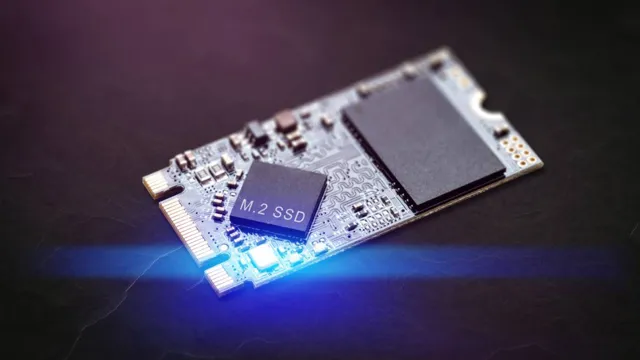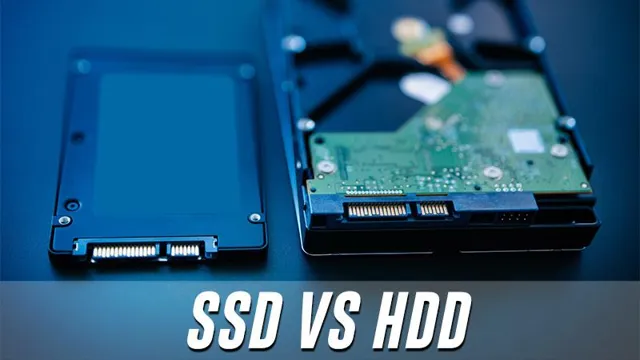Have you ever wondered how your computer’s SSD (Solid State Drive) stores and accesses all your data so quickly? Unlike traditional hard drives, SSDs use a completely different approach to store data. Rather than utilizing magnetic discs to read and write data, SSDs rely on NAND-based flash memory chips. But how exactly does this process work? In this blog, we’re going to delve into the mechanics of how data is stored on SSDs and explore the technology that has revolutionized the way we store and access our digital content.
So fasten your seatbelt and let’s dive in!
Introduction
When it comes to storing data on an SSD, there are a few key differences compared to traditional hard drives. Rather than using spinning disks to read and write data, SSDs use something called NAND flash memory. This type of memory works by storing data in cells that are arranged in a grid-like pattern.
Each cell can be charged with an electric current to hold a 1 or discharged to hold a 0, which represents binary data. The cells are grouped together in pages, which can then be combined into blocks for more efficient storage. Because SSDs don’t have any moving parts, they can access data much faster than traditional hard drives, making them a popular choice for performance-focused applications.
Additionally, SSDs are more durable and can withstand shocks and vibration better than traditional hard drives, making them ideal for use in laptops and other mobile devices. Overall, understanding how data is stored on an SSD is key to getting the most out of this powerful storage technology.
What is an SSD?
An SSD, or Solid State Drive, is a type of storage device that utilizes flash memory to store data. Unlike traditional hard disk drives, SSDs have no moving parts, allowing for faster access times and improved reliability. These drives are becoming increasingly popular due to their ability to significantly improve computer performance and speed up the loading time.
An SSD can be considered as a highly efficient and fast storage medium, akin to how a sports car can beat a sedan in a race. With no mechanical components to slow down processes, SSDs can access and transfer data much faster than hard disk drives, making them a highly sought-after component for gamers, video editors, and professionals working with large datasets. In summary, an SSD is a storage device that can revolutionize a computer’s performance by providing faster loading times and improved data transfer speed.

Why use an SSD for data storage?
If you’re in the market for a new storage solution, you may have heard about the benefits of using an SSD. SSD, which stands for solid-state drive, is a type of storage device that is becoming increasingly popular due to its many advantages over traditional hard disk drives. One of the main reasons to consider using an SSD for data storage is its speed.
An SSD can read and write data much faster than an HDD, which means that your programs and files will load more quickly. This can make a huge difference in terms of overall performance and productivity. Additionally, SSDs are more durable and less prone to damage from shock or other forms of physical impact, which makes them a better choice for portable devices.
Overall, if you want a storage solution that is fast, reliable, and built to last, an SSD is definitely worth considering.
SSD Architecture
If you’re curious about how data is stored on an SSD, it helps to understand the architecture of the device. SSDs use flash memory to store data, which consists of a grid of cells that can either be charged or discharged. Each cell represents a single bit of data, and groups of cells are organized into pages.
These pages, in turn, are grouped together into blocks. When you save data to an SSD, the controller sends the data to a free page within a block, and the page is programmed with the new information. When you delete data, the controller flags the pages containing the data as “invalid.
” Over time, as more data is written and deleted, the controller will look for blocks with a high number of invalid pages and move the valid pages to a new block. This process, called garbage collection, is important for keeping the SSD running smoothly and avoiding data fragmentation. By understanding the basic architecture of SSDs, you can better appreciate why they’re so fast and reliable compared to traditional hard drives.
NAND Flash Memory
NAND Flash Memory When it comes to SSD architecture, NAND flash memory plays a crucial role. It’s a type of non-volatile storage that allows data to be stored even when the power is turned off. Where NAND differs from traditional storage like hard drives is that it can perform access times with latency in the microsecond range and has excellent read/write speeds.
Moreover, it has a lower power consumption, which makes it ideal for laptops, mobile devices, and other portable devices that require energy-efficient drives. Furthermore, there are various types of NAND, such as SLC, MLC, and TLC, that have different levels of performance, durability, and cost. SLC is the fastest and most durable, whereas TLC is slower but cost-effective.
Understanding the different types of NAND flash memory and how they impact SSD architecture can help users pick the right storage device for their specific needs.
Controller Unit
SSD architecture The controller unit is a key element of SSD architecture. It acts as the brain of the solid-state drive and manages all of its functions. When you perform any operation on your SSD, such as reading or writing data, it is the controller unit that processes and manages it.
It coordinates communication between the host computer and the NAND flash memory chips, ensuring that data is stored and retrieved accurately and efficiently. The controller unit also performs important functions such as error correction and wear-leveling, which help to prolong the lifespan of the SSD. Without the controller unit, an SSD would not be capable of functioning at all.
The design of the controller unit is a critical factor in SSD performance, and different manufacturers may use different approaches to optimize its performance. Overall, the controller unit is a crucial component of the SSD architecture that plays a critical role in its overall performance and reliability.
Data Writing Process
When it comes to storing data on an SSD, it goes through a complex process that involves several steps. The data writing process begins with the computer processing unit (CPU) sending signals to the controller of the peripheral component interconnect express (PCIe) drive. The controller then converts the signals into instructions that the NAND flash memory can understand, and the data is written to the memory chips.
SSDs use a wear-leveling algorithm that distributes data evenly across the memory cells, ensuring that the cells wear out evenly. Every writing process needs to erase the previously stored data before adding new data. The SSD performs this function using a process called garbage collection.
The process maximizes the usable space by removing data that is no longer needed, marking the space as free, and waiting for new data to occupy the space. Following these steps ensures that the data stored on the SSD is secure, efficient, and long-lasting.
Page Programming
When it comes to data writing, there are a few important processes that must be understood in order to ensure accuracy and consistency. One key aspect of data writing is determining what data to collect and how to store it. This involves identifying the relevant data points for a given project or task, as well as determining the format and structure for organizing that data.
It also involves determining any necessary data validation rules to ensure that the data is entered correctly and is consistent across all relevant systems. Once this process has been completed, the data can be written into a database or file for later use. It’s important to note the importance of attention to detail in this process in order to avoid data errors or inconsistencies down the line.
Block Erasure
When it comes to storing data on solid-state drives (SSD), block erasure is an essential process. This process involves deleting entire blocks of data at a time, which is necessary because SSDs can only write new data to previously empty blocks. The block erasure process ensures that there is enough space for new data to be written, but it also has implications for the overall lifespan of the SSD.
Each block can only be erased a certain number of times, and when that limit is reached, the block becomes unusable. This is why it’s important to have a solid wear-leveling algorithm in place that distributes the data evenly across the SSD. By doing so, the same blocks won’t be constantly overwritten, ensuring a longer lifespan for the drive.
Overall, the block erasure process is a critical part of the data writing process for SSDs, and it’s important to understand how it works to get the most out of your storage device.
Conclusion
In conclusion, data is stored to an SSD in five fascinating ways. It’s like a symphony that creates beautiful notes by utilizing the latest technology. Each note has its own distinct sound, and each method of storing data has its own unique advantages.
Together they make for a perfect harmony that ensures fast and reliable performance. So, the next time you’re transferring files to an SSD, remember that you’re building a beautiful sonic masterpiece!”
FAQs
What is an SSD?
An SSD, or solid-state drive, is a type of storage device that uses flash memory to store data and has no moving parts.
How does data get stored on an SSD?
Data is stored on SSDs using NAND-based flash memory cells, which are organized into pages and blocks.
What is the difference between an SSD and a traditional hard disk drive (HDD)?
SSDs have no moving parts, while HDDs operate using spinning disks and read/write heads. SSDs are faster, more reliable, and typically more expensive than HDDs.
How long do SSDs last?
While SSD lifespan varies based on usage, most modern SSDs have a lifespan measured in years and can withstand hundreds of terabytes of data writes before reaching their limit.
How can I optimize my SSD’s performance?
To optimize your SSD’s performance, make sure you enable AHCI mode in your computer’s BIOS, update your firmware, and regularly perform TRIM operations to maintain the SSD’s performance over time.
